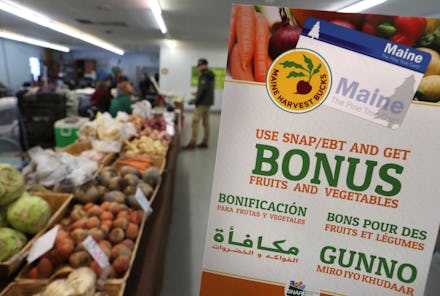No, the Trump food stamp cuts won’t feel anything like “Blue Apron”

How do you make $214 billion in cuts to food stamps over a decade sound like a win for recipients? If you’re the Trump administration, you invoke meal-kit service Blue Apron, which delivers fresh ingredients to customers’ doors.
Indeed, when President Donald Trump released his 2018 budget Monday, Office of Management and Budget director (and moonlighting consumer finance “protector”) Mick Mulvaney was quick to put a positive spin on the proposed cuts to the Supplemental Nutrition Assistance Program — as part of a broader push for improvements.
Food stamp recipients would start getting some benefits through “a Blue Apron-type program where you actually receive the food instead of receive the cash,” Mulvaney said. “It lowers the cost to us because we can buy [at wholesale prices] whereas they have to buy it at retail. It also makes sure they’re getting nutritious food. So we’re pretty excited about that.”
On paper, the proposal sounds promising. Taxpayers, for example, might be glad to hear the government expects to save more than $129 billion in costs.
And people being sent “America’s Harvest Box,” as it has been dubbed — those currently receiving more than $90 per month (or about 80% of the 21.5 million households participating in SNAP) — can look forward to receiving half their benefits in the form of packages of “nutritious... U.S. grown and produced food,” according to the U.S. Department of Agriculture.
But if you scratch below the surface and look into how the “Blue Apron-type” program might work in practice, the wholesome branding starts to fall away.
How does the “harvest box” compare to Blue Apron?
While Blue Apron delivers customers fresh fruits, vegetables, fish and meat, the USDA “harvest box” would contain “shelf-stable milk, juice, grains, ready-[to]-eat cereals, pasta, peanut butter, beans, canned meat, poultry or fish, and canned fruits and vegetables.”
For a sense of how that might look in reality, here’s a sample food package provided through another USDA service, the Commodity Supplemental Food Program, depicted on Nebraska’s health and human services website:
As you can see, the qualities that make food cheap, easy to package and slow to spoil also mean what you’re getting is typically less nutritious.
While you can certainly maintain a healthy diet that includes canned or stabilized foods in the mix, processed foods in general have less fiber and are heavier on salt, sugar, fat and refined (think: white flour) grains.
In fact, health data suggests that analogous government food programs for Native American communities have historically contributed toward higher rates of obesity and diabetes by pushing ingredients like lard, flour and sugar. And while the current program for Native Americans has improved (for example, people living on reservations are allowed to choose fresh fruits and vegetables over canned), a recent public health study found remaining “nutritional shortcomings,” suggesting there’s further room for improvement.
Put simply, food stamp recipients who currently make their own choices — like by buying fresh produce from farmer’s markets — could actually end up with less control and fewer nutritious options under the “harvest box” program.
Of course, the idea of getting food delivered to your home rather than having to go out and buy it has its appeal. But there are other ways the government can help people access grocery delivery without resorting to packages of nonperishable “commodity” food: For one, through a new pilot program rolling out in 2018, SNAP recipients in certain states are starting to be able to use their electronic benefit transfer cards to order fresh food online through retailers like Amazon, FreshDirect and Walmart.
Lest you think these benefits sound too cushy, the average SNAP recipient still gets less than $5 per day, according to 2017 data from the USDA. Beneficiaries cannot use that money on alcohol, tobacco products or pet food, and despite stereotypes, SNAP recipients do not buy soda or junk food at higher rates than non-SNAP users. While Congress previously held off on limiting SNAP benefits for candy, soft drinks and ice cream — because doing so would be costly and complicated — changes could still be on the horizon.
Finally, signs suggest alarm over waste and abuse is overblown: Food stamp-related fraud rates have dropped over the years to less than 1.5%.
Whatever your opinions on how food assistance in the United States could be improved (and whether you care about improving nutritional access for Americans, cutting costs, or both) the proposed “harvest box” program leaves many important questions unanswered.
How do you make sure the boxes you send people are customized to their needs — accounting for age, allergies and conditions like diabetes? How do you physically deliver these boxes, particularly to remote or rural areas? And how do you do all that without increasing, rather than decreasing, expenses?
After all, as Blue Apron — which has seen its stock price drop to less than $4 after an initial public offering at $10 per share — can attest, getting boxed food to people is hardly the easiest or cheapest task to pull off.
Sign up for the Payoff — your weekly crash course on how to live your best financial life